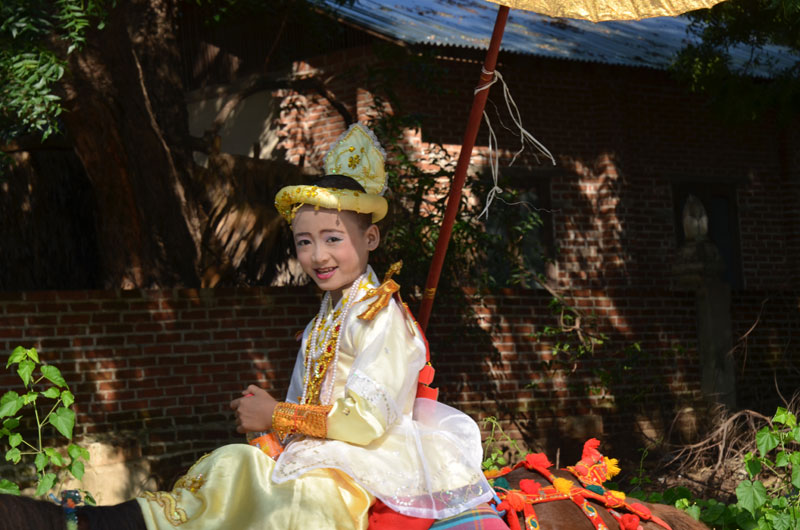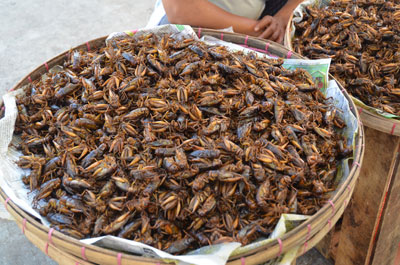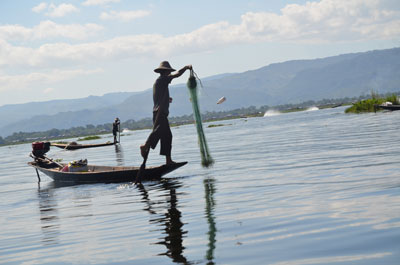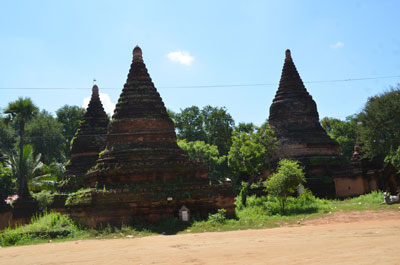Palaces and pagodas on a private tour of Myanmar
This article appears on page 48 of the May 2014 issue.

Carolyn Jones — Bend, OR
After reading a couple of articles in ITN (Dec. ’12, pg. 48 & Jan. ’13, pg. 24) about traveling with Myanmar Travel (No. 27, [27] Quarter, Shwe Pin Lon Part [4], North Dagon Myothit, Yangon, Myanmar; phone +95 9 7325 9401, myanmartravel.net and travelwithustoasia.com), my husband, David, and I contacted owner Myriam Grest to investigate taking a private tour through Southeast Asia, including a visit to Myanmar. Myriam worked with us to provide one of the best trips we have taken. Her residing in Myanmar provided an in-depth perspective we could not have obtained otherwise.
Our November 2013 tour, which cost $10,644 for two for 25 days, included daily drivers and guides; admission to all sites; eight flights within Asia; tourist-class hotels with breakfast, and some meals in Myanmar. (Some meals in Vietnam and all meals in Bhutan, the other countries we visited on this tour, were also included.)
Getting there
We left our home in Bend, Oregon, at 6 a.m. in the first snowstorm of the year and flew to San Francisco where, three hours later, we caught our 12-hour flight to Tokyo. After a 3-hour layover, we boarded our last flight, to Bangkok.
We arrived at the international airport at 11 p.m. and quickly discovered that all the major hotels had shuttles. We stayed overnight at the Miracle Hotel near the airport, since we had a morning flight to Yangon. However, our flight left from the domestic airport, which was on the other side of town, so we had to get up at 3:30 a.m.
Our hotel arranged for a taxi, which cost $20 — reasonable, considering the distance. A word of caution — be sure to use only metered taxis in Bangkok.
We arrived in Yangon and, after a long drive into the city from the airport, checked into our hotel. We then took a walking tour of the old part of the city.
The British influence on the buildings was evident; City Hall, Pansodan Street and the old Port Authority all revived visions of life under British rule.
Following the walking tour, we took a short rickshaw ride along Mawtin Jetty, then finished the day in Scott’s Market (aka Bogyoke Aung San Market), which was filled with shops selling food, jewelry, clothing, lacquerware and thanaka, the cream that women and children wear to lighten their skin and protect it from the sun. Historical records show that it has been in use for more than 2,400 years.
Bagan and Bago
To avoid rush-hour traffic, we left early the next morning for our flight to Bagan. Yangon’s airport was mass chaos, with at least eight airlines leaving out of only two gates. There was no signage, so it was necessary to continually confirm with staff when it was time to leave. We were issued a sticker with our airline’s name, but many of the stickers looked the same.
In Bagan we had a full day, with a diverse selection of the most important temples and pagodas on our itinerary. The Shwezigon Pagoda was built by King Anawrahta in the 11th century as a religious shrine. The Gu Byauk Gyi Temple had exquisite murals of Jatakas (stories of the former lives of the Buddha), and the Ananda Temple had four huge, standing Buddhas and numerous seated figures in niches around the galleried interior.
The city is divided into new and old Bagan and has been ravaged by many earthquakes over the years. As we traveled from pagoda to pagoda, we stopped along the way to watch a farmer harvesting his peanut crop with his hand plow and Brahma bull.
We ended the day by climbing to the top of the Shwesandaw Pagoda to enjoy the sunset over the ancient city.
Our drive through rush-hour traffic to Bago took over two hours. At the local market, there was an amazing variety of fruits, vegetables, dried fish and household goods.
Continuing on, the Kha Khat Wain Kyaung Monastery, which houses more than 1,000 monks, was our next stop. It was, indeed, a peaceful place. We finished the day at the Golden Palace (Kanbawzathadi Palace), a 14th-century palace renovated in 1992. Its ornate friezes make it truly spectacular.
While in Bago, our itinerary included a drive to Mt. Popa to visit the great extinct volcano. Rising out of the shimmering heat, the solitary volcanic crag of Mt. Popa is home to Myanmar’s most powerful nats, or spirits.
On to Mandalay
After a short flight to Mandalay the next morning, we drove to Sagaing, 21 kilometers southwest of Mandalay, to visit Kaunghmudaw, an enormous dome-shaped pagoda. In Amarapura, our visit to the Mahagandayon Monastery was in time to see more than 1,000 monks who had lined up for their second meal of the day. Massive pots of rice were prepared, stirred with huge poles.
The monks ranged from children to old men, and each carried a pot for his rice. In addition, worshipers lined the road to give them gifts, from money to toothpaste and soap.
The next day we drove to the top of Mandalay Hill, a vantage point for panoramic views of the city. The Kuthodaw Pagoda, a stop along the way, has the world’s biggest book, with stone slabs of Buddhist scriptures. Later we visited Mahamuni Pagoda with its spectacular statue of Buddha covered in thick layers of gold leaf.
To end the day, we took a riverboat from Kywezon Jetty to the ancient capital of Mingun to visit the Settawya Pagoda, containing a footprint of the Buddha.
In the morning, a boat ride on Inle Lake took us to ancient Bagan to see its Shan-style pagodas. Before hiking to the pagodas, we visited a local market and were fortunate to see the Shan hill people, who walk for many hours down from the mountain towns to do their grocery shopping there once a week. Many were in traditional dress and carried huge packs to transport their purchases. We never saw them without smiles on their faces.
The pagodas, which numbered over 1,050, were from the 12th century. The higher we walked, the more beautiful they became, though many were in the process of being renovated. Unfortunately, many of the ones at the lower level were ravaged by vine and tree growth, causing them to split and fall away.
After lunch at one of the many floating restaurants, we visited the Phaung Daw Oo Pagoda, housing five sacred Buddhas. Legend has it that as the Buddhas were being transported from another temple, the boat carrying them sank. Four were recovered, but the fifth was lost. The next morning, the fifth one appeared in the temple. Now only four ever leave the pagoda, and they have become shapeless from constantly being covered with gold leaf.
Our last visit was to the large, very old monastery on Inle Lake, Nga Phe Chaung. The façade is the original teak, although its 64 pilings have been replaced.
We had dinner two nights in a row at Thanakha Garden (43 Thar Zi Quarter, Nyaung Shwe), a family-run restaurant serving Western and Burmese food. Dinner for two with beer came to about $10.
On the walk back to our hotel, I almost ran into a cow! Walking at night is not for the faint of heart.
Back to Yangon
On the way to the airport for our flight back to Yangon, we stopped at the Shwe Yan Pyay Monastery, built in 1889. There were 38 novices there. Buddhist boys are all required to become novices, although some stay only a short time.
While they recite their prayers daily and learn Buddhist teachings, they still were boys, and we saw several playing with origami while reciting.
The drive to the airport in Heho was beautiful, across the mountains and through rice fields. It was a relief to have a local driver who was familiar with the area and the erratic drivers.
Our flight to Yangon was delayed for over an hour, so we spent the time watching the totally disorganized passenger loading system.
After our arrival in Yangon, we drove to see the Shwedagon Pagoda. This massive bell-shaped stupa rises nearly 100 meters above its hilltop surroundings.
The original stupa was built to enshrine eight strands of Buddha’s hair. Plated with more than 30 tons of glittering gold and dating back more than 2,500 years, it has become the symbol of Myanmar.
After checking out of our hotel, we went to the National Museum. While the museum was not of the highest quality and the lighting was terrible, it did have a lot of splendid artifacts.
Our thanks go to Myanmar Travel for arranging this wonderful trip.



